|
|
Today volunteers Bill and Bob spent the morning respectively cleaning and counting Echinacea achenes. Bill (pictured below) came across a receptacle that had a big hole in it–probably due to a burrowing critter:


In other news, Shona Sanford-Long, one of the 2012 summer REU interns, is here in the lab working on her Echinacea hybridization project. She spent the morning meticulously extracting achenes from the Echinacea pallida x angustifolia crosses she performed last summer.
David Lowenstein, a PhD student from University of Illinois at Chicago, came to the lab at the Chicago Botanic Garden in December to use our x-ray machine for his research project. One of the species he using in his project is Echinacea purpurea.

David x-raying a sample of Echinacea fruits (achenes).
Here’s what David had to say about his project…
I am studying pollinators in Chicago and whether vegetable crops and wild flowers in various neighborhoods in Chicago receive sufficient pollination. To investigate this, I used a mobile garden consisting of eggplant, cucumber, and purple coneflower. Potted plants of these species were transported to Chicago neighborhoods and left outside for four and half hours. I observed bee visits to focal plants, sampled the neighborhood floral community, and allowed the plants to mature under pollinator exclusion netting in the UIC greenhouse to measure pollination services. I measured pollination of purple coneflower by X-raying the achenes at the Chicago Botanic Garden and recording the proportion of full achenes from each Echinacea flowerhead. I found a positive relation between bee abundance and human population density, and I will use data from X-rayed achenes to determine if pollination services are also related to population density or other land cover variables. To read more about this project that will continue in summer 2013, visit http://www.uic.edu/labs/minor/urban_pollination.html
Here are three of his x-ray images. If you click & enlarge these images, you will see that some achenes are empty and others have embryos.



LFC students Marissa Ruiz and Courtney King created this fabulous poster using samples from my 2012 Helianthus experiment for my thesis. Indeed, we have significant support for the self-incompatibility of the genus.

Bio 384 poster final.pdf
We are making progress on the 2012 harvest. Today, volunteers Lois and Susan are extracting achenes from Echinaea heads and placing them in envelopes. For this batch of heads, we are trying out a protocol of saving any leftover plant dust in separate envelopes.

We also have a lot to finish from the 2011 harvest. On Friday we started counting achenes from an experiment that examines the effects of burning on offspring fitness. Each plant came from a mother that was either burned or unburned the year before germination.
In other news, we have a new member of the lab. Marie is a sophomore from Carleton College and is taking advantage of her winter break to gain some research experience. This month she will be processing some of the heads from Kelly’s Kapsar’s project on flowering phenology. Today, Stuart taught her how to extract achenes.

As you can see in this lovely motivational diagram, we finally finished counting last year’s achenes from the 1999 experimental plot.

The next step for this batch will be to collect a random sample of achenes from each flower head to estimate pollination rates. We can tell whether an achene is “full” (contains an embryo) or “empty” (does not contain an embryo) based on its weight. We can estimate pollination rates based on the ratio of full and empty achenes. However, there are some achenes whose weight does not give us any information about pollination. Some are so small they never produce an embryo, some are damaged by insects, some are damaged during removal from the flower head, etc. If we weighed these, they would show up as “empty”, even though they may have been pollinated. Therefore. when we select a random achenes for weighing, we have to differentiate between those that are informative about the pollination environment (full or empty) and those that are not informative (small, sterile, damaged, etc.).
For this batch, we are starting a new randomization protocol that assigns achenes to categories of “informative” (possibly full or definitely empty) and “uninformative” (sterile, undersized, damaged). Both are part of the random sample, but only the informative achenes are weighed. It’s a subtle distinction from what we were doing before, but it will be important for our results.
Now that we have reached our goal in counting, we have started processing the heads we harvested in 2012. Today volunteers Katharine and Sam are trying out a new protocol for removing the achenes from Echinacea heads. Previously, we through away any dust left over from removing achenes. This time, we are saving the dust in separate envelopes. That way, we will be able to figure out whether the dust we throw away contains fragments of achenes. Also, we will be able to compare scans with and without the extra dust to see whether removing dust makes a difference in the accuracy of our count data.

This week has brought us further along on our goal of counting and randomizing all of the achenes from 2011. Here is volunteer Kathryn Eber, looking pleased to have her picture taken. Thanks to her and the other volunteers, we are nearly finished counting the 4000 batch of the 2011 harvest.

On Wednesday October 31st, we welcomed several students from Lakeforest College for the first session of a four week internship. Meet Randen, who is working with me to learn how to identify ants:

When he came in, he had no experience identifying insects or using taxonomic keys. By the time he left, he was able to identify ants to genus and–for some genera–to species. His project is to compare ant species collected from burned and unburned units of the Staffenson prairie preserve. Ants are a crucial component to terrestrial ecosystems: they move dirt, they prey on many critters, and they protect other critters like aphids. If fire influences the community of ant species in a prairie remnant, there may be cascading effects throughout the ecosystem. Naturally, I’m excited to see what Randen finds out during his project.
Photo of scanned achenes. The dot indicates that the achene has been counted. The pencil shaped item in the center of the image is the counting tool. Place the point on a achene and hit the enter key and the “dot” is placed as well the count increased.

Bill Wallin counting Echinacea achenes (2011).

Charlynn Schweingruber making a random sample of achenes (2011) for weighing.

|
|



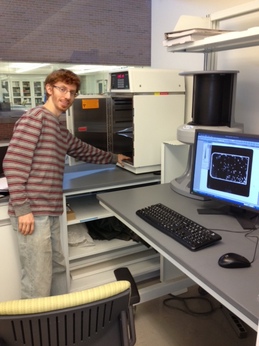
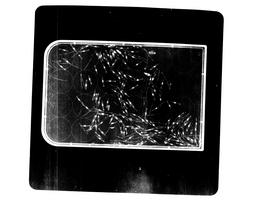
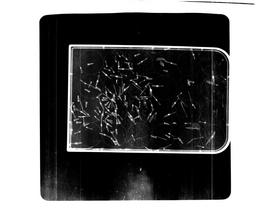


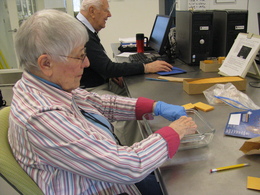
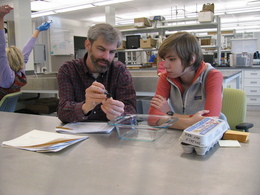
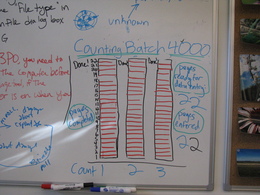
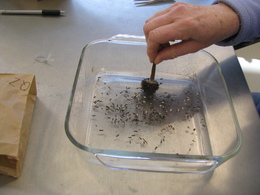

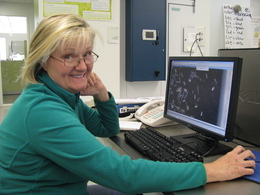
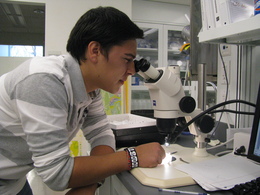
-thumb-260x202-136589.jpg)
-thumb-260x202-136086.jpg)
